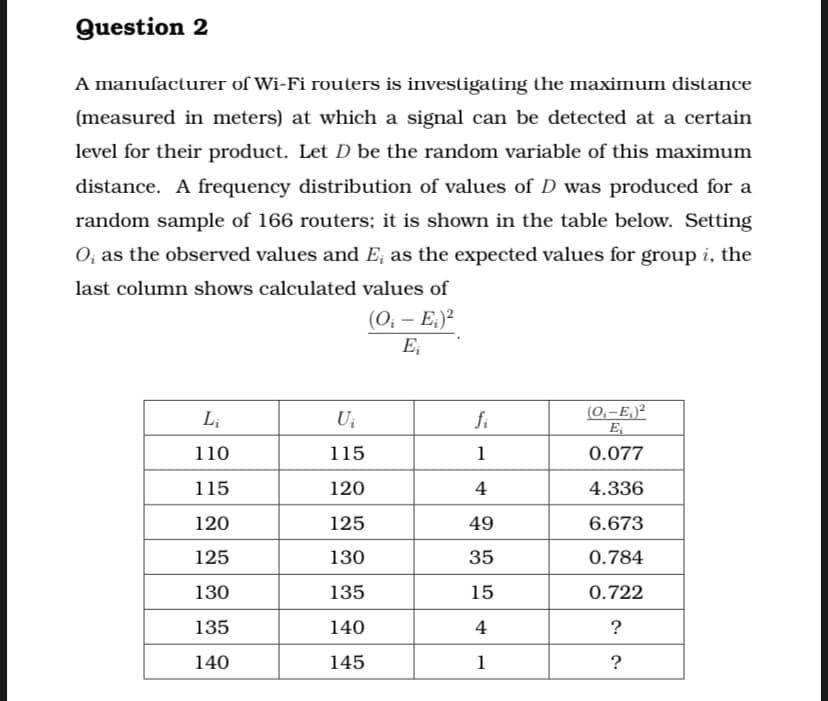Assume that the random variable D follows the Normal distribution. For the sixth and seventh groups, calculate the values of the terms (0, – E,)²
Assume that the random variable D follows the Normal distribution. For the sixth and seventh groups, calculate the values of the terms (0, – E,)²
MATLAB: An Introduction with Applications
6th Edition
ISBN:9781119256830
Author:Amos Gilat
Publisher:Amos Gilat
Chapter1: Starting With Matlab
Section: Chapter Questions
Problem 1P
Related questions
Question

Transcribed Image Text:2. Assume that the random variable D follows the Normal distribution.
For the sixth and seventh groups, calculate the values of the terms
(0; – E:)²
E;
If you have not calculated the values of the sample mean and stan-
dard deviation, use D
26m and s =
5m.

Transcribed Image Text:Question 2
A manufacturer of Wi-Fi routers is investigating the maximum distance
(measured in meters) at which a signal can be detected at a certain
level for their product. Let D be the random variable of this maximum
distance. A frequency distribution of values of D was produced for a
random sample of 166 routers; it is shown in the table below. Setting
O; as the observed values and E, as the expected values for group i, the
last column shows calculated values of
(0, - E.)²
E;
Li
fi
(0,-E,)?
E
110
115
1
0.077
115
120
4
4.336
120
125
49
6.673
125
130
35
0.784
130
135
15
0.722
135
140
4
?
140
145
1
Expert Solution
This question has been solved!
Explore an expertly crafted, step-by-step solution for a thorough understanding of key concepts.
Step by step
Solved in 2 steps with 3 images

Knowledge Booster
Learn more about
Need a deep-dive on the concept behind this application? Look no further. Learn more about this topic, statistics and related others by exploring similar questions and additional content below.Recommended textbooks for you

MATLAB: An Introduction with Applications
Statistics
ISBN:
9781119256830
Author:
Amos Gilat
Publisher:
John Wiley & Sons Inc

Probability and Statistics for Engineering and th…
Statistics
ISBN:
9781305251809
Author:
Jay L. Devore
Publisher:
Cengage Learning

Statistics for The Behavioral Sciences (MindTap C…
Statistics
ISBN:
9781305504912
Author:
Frederick J Gravetter, Larry B. Wallnau
Publisher:
Cengage Learning

MATLAB: An Introduction with Applications
Statistics
ISBN:
9781119256830
Author:
Amos Gilat
Publisher:
John Wiley & Sons Inc

Probability and Statistics for Engineering and th…
Statistics
ISBN:
9781305251809
Author:
Jay L. Devore
Publisher:
Cengage Learning

Statistics for The Behavioral Sciences (MindTap C…
Statistics
ISBN:
9781305504912
Author:
Frederick J Gravetter, Larry B. Wallnau
Publisher:
Cengage Learning

Elementary Statistics: Picturing the World (7th E…
Statistics
ISBN:
9780134683416
Author:
Ron Larson, Betsy Farber
Publisher:
PEARSON

The Basic Practice of Statistics
Statistics
ISBN:
9781319042578
Author:
David S. Moore, William I. Notz, Michael A. Fligner
Publisher:
W. H. Freeman

Introduction to the Practice of Statistics
Statistics
ISBN:
9781319013387
Author:
David S. Moore, George P. McCabe, Bruce A. Craig
Publisher:
W. H. Freeman